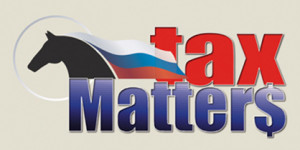Tax Matters
Click here to read the complete article
The Material Participation Test Can Trick Taxpayers
by John Alan Cohan, Attorney at Law
 Often enough taxpayers who are audited in connection with their farming or livestock activities are questioned on the issue known in the tax law as the “material participation test.” Under this legal test, you are permitted to deduct losses against outside salary and wages only if, among other things, you “materially participate” in the activity. Many duties, such as training of animals, showing of show horses and racing of race horses, are delegated to qualified experts, and sometimes the IRS will question the validity of your own participation in decisionmaking, in an effort to say you have failed to meet the material participation test.
Often enough taxpayers who are audited in connection with their farming or livestock activities are questioned on the issue known in the tax law as the “material participation test.” Under this legal test, you are permitted to deduct losses against outside salary and wages only if, among other things, you “materially participate” in the activity. Many duties, such as training of animals, showing of show horses and racing of race horses, are delegated to qualified experts, and sometimes the IRS will question the validity of your own participation in decisionmaking, in an effort to say you have failed to meet the material participation test.
This usually happens in the context of ventures that involve a partnership or joint venture. For instance, Joseph Machado of Long Beach, California, entered into the LB Partnership with four other partners to purchase a broodmare named La Barbara. One partner was the managing partner and was responsible for maintaining the books and records of the partnership and for paying all expenses. The partnership made decisions by majority vote of all six partners. The broodmare was bred to a number of stallions, but the partnership generated losses over a period of 7 years.
The Tax Court denied Mr. Machado the right to write off these losses against his income from a trucking business he owned because it held he did not materially participate in the partnership. Accordingly, his losses were limited by the passive income rules of Section 469 of the IRS Code and could not be used to offset his nonpassive income.
This case illustrates the importance of obtaining advance legal guidance whenever you enter into a partnership if you intend to write off possible losses against nonpassive income sources. The material participation test is something you must plan on meeting and complying with, and is not something to be treated lightly. As a general rule, a taxpayer will be regarded as materially participating in a partnership if he is involved in the operation of the activity on a “regular, continuous, and substantial” basis.
What does that mean? A threshold requirement for meeting this test is that the taxpayer has participated in the activity for more than l00 hours during each taxable year. A taxpayer can establish the extent of his participation by any reasonable means including “the identification of services performed over a period of time and the approximate number of hours spent performing such services during such period, based on appointment books, calendars, or narrative summaries.” But in the case of Mr. Machado, the only evidence he presented at trial regarding participation in the partnership was his uncorroborated testimony that he spent hundreds of hours researching potential stallions to breed with La Barbara, and a calendar log that reflected l5 entries for phone calls he made relating to the partnership. Even with that meager evidence, the number of hours shown was less than l00 hours per year.
The kind of activities that a taxpayer should be able to document during each year may include the following: consulting with advisers, other breeders and veterinarians, attending horse shows, horse sales, or races, seeing horses being worked, keeping business records, discussing matters with one’s spouse and other partners, implementing or formulating business plans and revising them, reviewing finances, making cost projections, making disbursements, speaking with vendors on the telephone or in person, talking to potential customers, grooming horses and tending to the physical labor that is part of proper animal husbandry, and performing other tasks and decision-making functions. But it is imperative that records be kept to reflect the number of hours involved, and the number must be l00 or more hours per year.
In my opinion, the material participation test does not apply to ordinary stallion syndications, which are not partnerships in the technical sense, but instead are co-ownership entities where each owner has a fractional interest in the stallion. Still, the IRS has been known to challenge taxpayers on the material participation test in these contexts. I think part of the reason is that some revenue agents are confused as to the application of this provision of tax law.
It is important to keep in mind that the material participation test is supplemental to the overall IRS Regulations concerning the objective intention to make a profit. Even if you can prove material participation in a horse activity, the IRS could still find the venture was merely a hobby by arguing that you do not have the overall intention to be engaged in a trade or business for profit or that there are other elements, such as recreation, lack of reliance on experts, or insufficient showing of the amount of time expended in the venture — to satisfy IRS Regulations on the subject.
John Alan Cohan is a lawyer who has served the horse industry since l98l. He serves clients in all 50 states, and can be reached at: (3l0) 278-0203 or by e-mail at johnalancohan@aol.com. His website is www.JohnAlanCohan.com.










